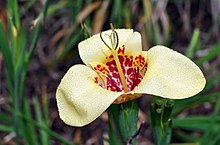| Tigridia | |
|---|---|

| |
| Tigridia pavonia in Mexico | |
| Scientific classification | |
| Kingdom: | Plantae |
| Clade: | Tracheophytes |
| Clade: | Angiosperms |
| Clade: | Monocots |
| Order: | Asparagales |
| Family: | Iridaceae |
| Subfamily: | Iridoideae |
| Tribe: | Tigridieae |
| Genus: | Tigridia Juss. |
| Type species | |
| Tigridia pavonia (L.f.) Redouté | |
| Synonyms | |
List
| |
Tigridia /taɪˈɡrɪdiə/, is a genus of bulbous or cormous flowering plants belonging to the family Iridaceae. With common names including peacock flowers, tiger-flowers or shell flowers, they have large showy flowers; and one species, Tigridia pavonia, is often cultivated for this. The approximately 60 species in this family grow in the Americas, from Mexico down to Chile.
The tigridia flower is short lived, each often blooming for only one day, but often several flowers will bloom from the same stalk. Usually they are dormant during the winter dry-season. The roots are edible and were eaten by the Aztecs of Mexico who called it cacomitl, and its flower ocēlōxōchitl "jaguar flower".
It was first published by French botanist Antoine Laurent de Jussieu in his book Genera plantarum on page 57 in 1789.
The genus name Tigridia means "tiger-like", and alludes to the coloration and spotting of the flowers of the type species Tigridia pavonia.
Species
There are 60 species accepted by Plants of the World Online;
- Tigridia albicans Ravenna - Tacna Province in Peru
- Tigridia alpestris Molseed - Mexico
- Tigridia amatlanensis Aarón Rodr. & García-Mend - Oaxaca
- Tigridia arequipensis Montesinos, A.Pauca & Revilla
- Tigridia augusta Drapiez - central + southern Mexico
- Tigridia bicolor Molseed - Oaxaca
- Tigridia catarinensis Cruden - San Luis Potosí
- Tigridia chiapensis Molseed ex Cruden - Chiapas
- Tigridia chrysantha Cruden & S.J.Walker ex McVaugh - Jalisco
- Tigridia citrina (Cruden) Goldblatt
- Tigridia coerulea Goldblatt
- Tigridia convoluta (Ravenna) Goldblatt - Oaxaca
- Tigridia conzattii (R.C.Foster) Goldblatt - Oaxaca
- Tigridia dugesii S.Watson - Jalisco
- Tigridia durangense Molseed ex Cruden - Durango
- Tigridia ehrenbergii (Schltdl.) Molseed - Mexico
- Tigridia estelae López-Ferr. & Espejo - Durango
- Tigridia flammea (Lindl.) Ravenna - Michoacán
- Tigridia fosteri Goldblatt
- Tigridia galanthoides Molseed - southern Mexico
- Tigridia gracielae Aarón Rodr. & Ortiz-Cat. - México State
- Tigridia hallbergii Molseed - central + southern Mexico, Guatemala
- Tigridia heliantha (Ravenna) Goldblatt
- Tigridia hintonii Molseed - Guerrero
- Tigridia huajuapanensis Molseed ex Cruden - Oaxaca
- Tigridia huyanae (J.F.Macbr.) Ravenna - Lima Province in Peru
- Tigridia illecebrosa Cruden - central + southern Mexico
- Tigridia immaculata (Herb.) Ravenna - Oaxaca, Chiapas, Guatemala
- Tigridia inusitata (Cruden) Ravenna - Guerrero
- Tigridia latifolia (Weath.) Goldblatt
- Tigridia longispatha (Herb.) Goldblatt
- Tigridia mariaetrinitatis Espejo & López-Ferr. - Oaxaca
- Tigridia martinezii Calderón - Hidalgo
- Tigridia matudae Molseed - México State
- Tigridia meleagris (Lindl.) G.Nicholson - central + southern Mexico, Guatemala
- Tigridia mexicana Molseed - central + southern Mexico
- Tigridia minuta Ravenna - Apurímac + Ayacucho Provinces in Peru
- Tigridia molseediana Ravenna - Oaxaca, Guatemala
- Tigridia mortonii Molseed - México State
- Tigridia multiflora (Baker) Ravenna - central + southern Mexico
- Tigridia oaxacana (Molseed) Goldblatt - Oaxaca
- Tigridia orthantha (Lem.) Ravenna - Oaxaca, Chiapas, Guatemala
- Tigridia pavonia (L.f.) Redouté - Mexico, Guatemala, El Salvador, Honduras
- Tigridia pearcei (Baker) Ravenna - Huánuco region in Peru
- Tigridia philippiana I.M.Johnst. - Tarapacá + Antofagasta Provinces in Chile
- Tigridia potosina López-Ferr. & Espejo - San Luis Potosí
- Tigridia pugana Aarón Rodr. & Ortiz-Cat. - Jalisco
- Tigridia pulchella B.L.Rob. - Jalisco, Michoacán
- Tigridia purpusii Molseed - Puebla
- Tigridia purruchucana (Herb.) Ravenna - Lima Province in Peru
- Tigridia raimondii Ravenna - Arequipa Province in Peru
- Tigridia rzedowskiana Aarón Rodr. & Ortiz-Cat. - Querétaro
- Tigridia seleriana (Loes.) Ravenna - Oaxaca, Chiapas, Guatemala
- Tigridia suarezii Aarón Rodr. & Ortiz-Cat. - Jalisco
- Tigridia tepoxtlana Ravenna - Morelos
- Tigridia tuitensis (Aarón Rodr. & Ortiz-Cat.) Goldblatt
- Tigridia vanhouttei(Baker) Espejo & López-Ferr - central + northeastern Mexico
- Tigridia venusta Cruden - Michoacán
- Tigridia violacea Schiede ex Schltdl. - central + southern Mexico
Hybrids
Several hybrids exist, including; Tigridia × mathewii J.M.H.Shaw, first published in Phytoneuron 2015-53: 4 in 2015. It is an artificial hybrid, a cross of T. orthantha × T. pavonia.
Distribution
They are native to the countries (and regions) of; northern Chile, El Salvador, Guatemala, Honduras, Mexico and Peru.
They have been introduced into: Bolivia, Colombia, Ecuador and Madeira.
References
- ^ "Tigridia Juss. | Plants of the World Online | Kew Science". Plants of the World Online. Retrieved 30 October 2023.
- Sunset Western Garden Book, 1995:606–607
- NRCS. "Tigridia". PLANTS Database. United States Department of Agriculture (USDA). Retrieved 10 December 2015.
- Davidse, G., M. Sousa Sánchez & A.O. Chater. 1994. Alismataceae a Cyperaceae. 6: i–xvi, 1–543. In G. Davidse, M. Sousa Sánchez & A.O. Chater (eds.) Fl. Mesoamer.. Universidad Nacional Autónoma de México, México, D. F.
- Manning, John; Goldblatt, Peter (2008). The Iris Family: Natural History & Classification. Portland, Oregon: Timber Press. pp. 253–56. ISBN 978-0-88192-897-6.
- Idárraga-Piedrahita, A., R. D. C. Ortiz, R. Callejas Posada & M. Merello. (eds.) 2011. Flora de Antioquia: Catálogo de las Plantas Vasculares 2: 9–939. Universidad de Antioquia, Medellín
- Standley, P. C. & J. A. Steyermark. 1952. Iridaceae. In Flora of Guatemala - Part III. Fieldiana, Botany 24(3): 159–178
- "Tigridia × mathewii J.M.H.Shaw | Plants of the World Online | Kew Science". Plants of the World Online. Retrieved 30 October 2023.
Other sources
- Rodriguez, A. and K. Sytsma. 2006. Phylogeny of the "Tiger-flower" group (Tigrideae: Iridaceae): Molecular and morphological evidence. Pp. 412–424, in J.T. Columbus, E.A. Friar, J.M. Porter, L.M. Prince and M.G. Simpson (eds.). Monocots: Comparative Biology and Evolution, Vol. 1. Rancho Santa Ana Botanic Garden, Claremont.